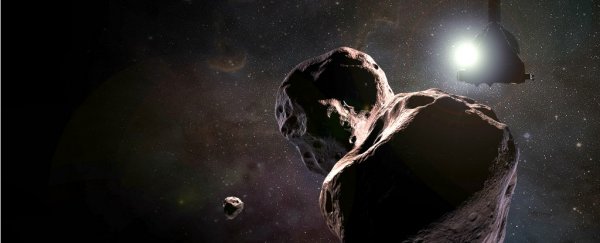NASA's New Horizons probe - the same one that gave us stunning photos of Pluto - has just woken up, approximately 6 billion kilometres (3.7 billion miles) from home.
It's currently flying through the Kuiper Belt, and off on an exciting mission scheduled for New Year's Day – the first-ever flyby of the Kuiper Belt object nicknamed Ultima Thule.
Ultima Thule, officially known as 2014 MU69, orbits a billion miles beyond Pluto, and according to the New Horizons team, "will be the most primitive world ever observed by spacecraft – in the farthest planetary encounter in history."
The hard-working spacecraft earned a spot in all of our hearts after its amazing flyby of Pluto back in 2015, returning incredible data for researchers, and showing off Pluto's icy heart.
But since 21 December 2017, New Horizons has been having a snooze, going into hibernation mode to save resources on its exceptionally long journey through the outer Solar System.
"We have a small team and when we put the spacecraft into hibernation, it takes less time for us [to operate New Horizons]", Alice Bowman, New Horizons' mission operations manager, told Loren Grush at The Verge.
"We can be spending it on developing the command set for the flyby, which is what we were doing."
But on Tuesday at 2:12am EDT (6:12 am UTC) radio signals confirming that New Horizons had executed on-board computer commands to exit hibernation reached the team at the Johns Hopkins Applied Physics Laboratory.
"Our team is already deep into planning and simulations of our upcoming flyby of Ultima Thule and excited that New Horizons is now back in an active state to ready the bird for flyby operations, which will begin in late August," said mission Principal Investigator Alan Stern, of the Southwest Research Institute.
The team is now collecting navigation tracking data, and sending commands to the probe via the Deep Space Network to begin preparations for the Ultima flyby.
And although it still has a few months to go before it reaches the mysterious object, it isn't actually that far in planetary terms.
New Horizons is approximately 262 million km (162 million miles) – less than twice the distance between Earth and the Sun – from Ultima, speeding 1,223,420 km (760,200 miles) closer each day.
The New Horizons team has actually made a number of online graphics here if you want to check the location of our favourite Kuiper Belt buddy coming up to the big day.
But don't mind us, we'll just be planning our New Years Day New Horizon party.
